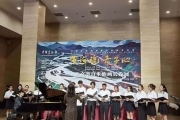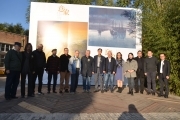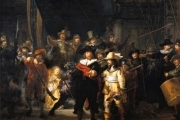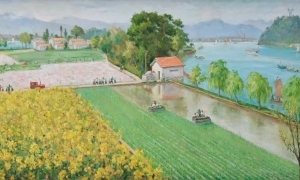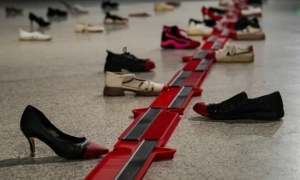Xiao Hong -The Series
1989年夏天还在内蒙师大就读油画专业的肖红去了敦煌,20多天的观摩之后,佛教或者说敦煌的独特审美在肖红的记忆中留下了难以消磨的印记。尝试了构成、描述、样式和符号的多重创作手段,经历了从单纯改造敦煌图像到镜像历史社会现实,肖红在油画语言的民族性和衔接当下社会的之间付诸诉求。如今把生活和工作主要放在呼和浩特的肖红似乎有些超离,低产创作的他在寻求描绘终极理想的方式——如何图绘西方极乐世界的景象。
In the summer of 1989, Xiao Hong, who was still studying in Inner Mongolia Normal University, went to Dunhuang. The more than 20 days’ inspection and study left with him a strong impression of the special esthetics of Buddhism or Dunhuang, which he found difficult to forget. By trying numerous methods including constructivism, narrative, pattern and symbolism and experiencing a process from purely reforming Dunhuang Images to mirroring social realities, Xiao Hong has been pursuing a language of oil painting in terms of its national characteristics and connection to current society. Now Xiao Hong, who is living and working mainly in Huhhot, seems to be a little unconventional; he is currently in a low yielding period and searching for a way to paint his ultimate ideal—the scenery of Western Paradise.
超离的终极 - 赵力对话肖红
对话者:肖红,赵力
时间:2010年3月18日 地点:林大画廊(北京)
The Ultimate of Unconventionality - Conversation between Zhao Li & Xiao Hong
Conversation by Xiao Hong & Zhao Li
Time: Mar. 18th, 2010
Location: Linda Gallery (Beijing)
1 西行敦煌 Go West to Dunhuang
赵力:你之前的作品线索还是比较清晰的,主要有四个阶段:“再造供养人”,94年到99年;“大路朝天”,99年到01年;然后是“艳阳天”,01年到03年;另外“知识青年”,从03年延续到现在。倒叙地说(?前面和后面都不是倒叙,逻辑不对吧?),你今后的方向是什么?
Zhao Li: The clue to the themes in your former works is clear in the four phases: “to Rebuild Providers” is from 1994 to 1999; “A Broad Road toward Sky” is from 1999 to 2001; “A Bright Sunny Sky” is from 2001 to 2003; and “Intellectual Youth” is from 2003 till now. So what’s your next direction?
肖红:这几年看了好多佛教的书,在想怎么把《无量寿经》描述的西方极乐世界图绘下来?
Xiao Hong: I read numerous books on Buddhism in recent years, and I am thinking about painting the Western Paradise described in Sutra of Infinite Life.
赵力:你提到了佛教主题性的问题,你对佛教是怎样认识的,你是佛教徒吗?
Zhao Li: You just mentioned themes in Buddhism, so what’s your opinion on Buddhism, are you a Buddhist?
肖红:不是佛教徒。我在1989年夏天到过敦煌,那会儿人很少,敦煌研究院的一位副院长因为我在动乱刚过的时候到这里很感动,就派人带我看壁画。二十多天,天天看,边看边听逐渐有了兴趣。回学校后,敦煌印象挥之不去,尝试着用构成方式把敦煌表现出来,这样一点点发展过来。
Xiao Hong: No, I’m not. I went to Dunhuang in the summer of 1989, when people seldom went there. A vice director of Dunhuang Research Institution was deeply moved by my visit, which was just after the turmoil, so he sent his researchers to show me the frescoes. I visited the frescos while listening to the stories every day for more than 20 days. After I went back to university, the impressive Dunhuang urged me to express them through constructivism, thus things began to develop gradually.
赵力:敦煌壁画的早期窟型是中心塔柱式的,有一个主像,周围是连续变化的壁画。 “再造供养人”系列的画面也都是有一个主像,其余画面围绕展开,这应该和你看到的窟型和氛围有关。
Zhao Li: The early form of Dunhuang fresco is of central tower style with a major character surrounded by continuous variations of murals. In the series of “to Rebuild Providers”, there is also a major character surrounded by other elements in each painting, which could relate to the fresco styles and atmosphere you saw previously.
肖红:几乎是一种拷贝,加上了绘画的样式。
Xiao Hong: It is almost a kind of copy, plus the form of painting.
赵力:这些作品好像有一种模拟的场景,而且不完全是抽象结构的,我因此看到了另一个问题,学习写实绘画的你到了敦煌以后,材料、构成包括肌理变成你考虑的主要问题,而且有一种现代的表现。
Zhao Li: It seems that there is a mimic scene for these works, which is not in completely abstract structure. Thus I learned something else, that after you (who studied realistic painting) arrived in Dunhuang, material and structure, including texture, became your major concern as well as a kind of modern expression.
肖红:对,当时更突出技术问题。
Xiao Hong: Right, technique was more important to me at that time.
赵力:敦煌壁画的颜色非常丰富,但“供养人”更多是黑白灰的微妙变化。在油画颜料、色阶变化方面,你是不是有着对中国绘画语言的诉求?近现代有很多人西行敦煌发掘民族根源性的东西,比如吴作人、董希文的油画都因此发生很大变化。去了敦煌,你的油画表现是不是出现了一种新的变化?
Zhao Li: The color of Dunhuang fresco is very profound, but “the Providers” shows more refined variations of black, white and gray colors. Do you pursue a language of Chinese painting in terms of oil colors and color level variation? Many artists went west to Dunhuang to discover national origins in Modern Times, such as Wu Zuoren and Dong Xiwen, and their oil paintings changed a lot as a result. After you went to Dunhuang, was there any new variation that appeared in your oil painting expression?
肖红:当时主要是被样式打动了。因为对油画材料熟悉,觉得油画也能表现这种肌理或者敦煌残破的感觉,就尝试着这么做。
Xiao Hong: I was moved mostly by the style at that time. I was familiar with oil painting materials and thought that this kind of Dunhuang texture and sense of decaying could also be expressed through oil painting, so this is what I tried to do.
赵力:85年到89年在艺术界出现很多画抽象、画材料的实验艺术家,你对这个流派有什么评价,他们和你有什么关系?
Zhao Li: There appeared many artists who experimented with abstract paintings and materials in the art circle during 1985 to 1989; what is your comment on this school, and what is the relationship between you and them?
肖红:当时我在内蒙上学,妥木斯先生的油画借鉴了很多汉像砖的东西,对我们有很大启发。去了敦煌后就边尝试边画。之前也受过八五新潮的影响,以及全国学文艺复兴前期那股思潮的影响。文艺复兴前期也是借鉴壁画,我看到东方壁画,觉得东方壁画也很有意思。
Xiao Hong: I was studying at university in Inner Mongolia at that time; Mr. Tuo Musi used many pictorial stones of Han Dynasty for reference in his oil paintings, which inspired us greatly. So I began to experiment on painting after I arrived in Dunhuang. The 85’ New Wave Art Movement and countrywide trend of learning from early Renaissance both influenced me then. It was also popular to take fresco as reference in early Renaissance; and having seen Eastern frescoes, I thought they were also very interesting.
2.中国油画怎么办 What is the Future of Chinese Oil Painting
赵力:在“大路朝天”系列里,你借鉴了彩砖、墓室壁画的方式,使用了一些佛像语言,比如佛手佛脚。我从画面中读到的是世俗生活和佛教符号的结合,这种现世生活和佛教彼岸之间的关系,你作何理解?
Zhao Li: In the series of “A Broad Road toward Sky”, you used encaustic bricks and murals in coffin chambers as references as well as some language in Buddhist images, such as Buddha’s hands and legs. What I read in the paintings is a combination of common life and Symbols of Buddha. So what’s your understanding of this kind of relationship between this life and that Paradise?
肖红:是北方农村生活给我的触动。北方农村,尤其到了夏天,艳阳高照、懒洋洋的,劳作也是在缓和、不紧张的节奏中进行。我把这种状态以及敦煌壁画里的世俗画面改造了一下,同时也是想画井田的东西。
Xiao Hong: It was the life in the northern countryside that touched my heart. In the northern countryside, especially in summer, the sun shines high and leisurely so that even farmers work in a slow and relaxing rhythm. I reformed this state and the scenes of common life in Dunhuang fresco, and also I wanted to paint something about the well-field.
赵力:这样看来,之前的结构性考虑到了这个阶段带有了符号性的考虑,比如井田或者佛像,包括祥云的表现,带有构成性,又与现实穿插。从绘画角度来说,我觉得你是用比较单纯的方式去表现。这段时间,也有一些艺术家开始这么做,比如尚扬。当时你,包括你身边的艺术家都在想些什么问题?
Zhao Li: It helped to explain that your previous focus on structure developed into a focus on symbolic meaning in this phase, such as the well-field or Buddhist images, and the expression of lucky clouds as well; they not only showed a characteristic of constructivism but also interweaved with reality. In terms of painting, I think you used a simple expression. Some other artists also began to do so during this time, such as Shang Yang. So what were the questions you and the artists around you thought about at that time?
肖红:技法上考虑更多,也走了走构成主义,但还是在技法、风格上考虑更多。
Xiao Hong: I thought more about technique and adopted constructivism, but still technique and style were more of a concern.
赵力:一个是技法,我觉得还有一个考虑是油画语言在中国的问题。要脱离西方,又要在现代范围里考虑油画语言的改造和建构,要有中国的感觉。
Zhao Li: One question is about technique, and I think another question is about the language of oil painting in China; it not only needed to be separated from western influence, but also to be reformed and constructed within the scope of being contemporary, and to show a feeling of China.
肖红:那段时间很看重这个,考虑中国油画怎么办。
Xiao Hong: We were really concerned about this during that time and thought about the future of Chinese oil painting.
赵力:从这个时间角度看,整个90年代大家都在找一个出路。找着出路以后,各走各的道路,各有各的起点,各有未来的目标。所以这个阶段的艺术创作既有共性的东西,反映中国艺术的整体面貌,又有个人的、变化性的东西。“大陆朝天”里不同透视组合在一个画面中,有一些东西既是符号的,又是描述的,很复杂,很有意思,应该是敦煌系列的自由发展。
Zhao Li: In terms of the time, all of us were searching for a way out during the entire 90s. Once finding the way, everyone kept his own direction and set his own beginning as well as future goals. So the art works in this phase not only had something in common and reflected a general characteristic of Chinese art, but also had something personal and changeful. In “A Broad Road toward Sky”, different perspectives are combined into one frame, in which there is something symbolic and narrative, very complicated, and very interesting. It can be considered as a free development of Dunhuang series.
3 现世的佛界 the Sphere of Buddha in This Life
赵力:在90年代你可能主要是往回看,找根源和基础。到“艳阳天”发生了很大变化,回到基本的背景和人物之间的关系,回到绘画的基础上,比如有人物、有地平线、比较现世化,这和前面有很大不同,从这个角度来说,怎么会到“艳阳天”系列?
Zhao Li: In the 90s, maybe you looked back for origin and base. But great changes occurred since “the Bright Sunny Sky”, in which your emphasis turned back to the basic relationship between background and characters, the basis of painting. For example there were characters and horizons, which appeared to be more secularized and greatly different from your previous works. In this sense, how did the series of “the Bright Sunny Sky” come into being?
肖红:这一段比较矛盾,一是刚来北京两年,生活比较困难,二是当时艺术界有了变化,新出现的当代艺术与我之前的绘画思维完全不一样,于是就在很乱的过程当中画了这么一批画。
Xiao Hong: It was contradictory in this phase, because firstly, it was hard for me to make a living when I stayed in Beijing for only 2 years; and secondly, something changed in the art circle at the time, the new contemporary art was completely different from my previous thoughts on painting. Thus I made this series of paintings in chaos.
赵力:从美术史和批评的角度来看这个阶段的你实际上是受到了一些影响,或者你开始思考一些问题,比如画面出现了人物。
Zhao Li: In terms of art history and criticism, you received some influence in this phase actually, or you began to think about some questions, for example, characters appeared in your paintings.
肖红:是儿童。
Xiao Hong: It is a child.
赵力:为什么没有脸,没有脸部表情的表现?
Zhao Li: But why is there no face, and no facial expression?
肖红:主要是这个小孩很生动,动作很有意思,就把脸抹去了,当然还是有构成的考虑。
Xiao Hong: Mainly because this child is vivid and his actions are quite interesting, so I neglect his face, but of course practicing constructivism is also my concern.
赵力:把人物看成构成的一部分,但已经开始注重人物的动态,因而现实感强了。也出现了画面背景,不过这个背景还是跟前面系列有很大关系,色调也接近。为什么要画小孩?
Zhao Li: To take characters as one part of the construction, and also to begin emphasizing their movements, thus strengthening the feeling of reality. Background also appeared, but it still very much relates to your previous series, and the hues are also similar. But why did you paint Children?
肖红:小孩显得幼稚,没有脸面,没有表情,呆呆的,踩在一个佛陀的世界上,把他当做一个小护法神。一些幼稚的孩子去护着佛陀的世界。
Xiao Hong: Children seem naïve, without face and facial expression, stamping on the sphere of Buddha; his is considered as a little dharma protector. It is some naïve children who protect the sphere of Buddha.
赵力:很多艺术家画孩子是因为他有了孩子,对孩子有一种关心,比如四川的一些画家。还是说,你只是把孩子当作关注到的一个现象,当作一种表达方式?
Zhao Li: For many artists, the reason to paint children is that they have children and care about children, such as some painters in Sichuan. Or do you only take children as a phenomenon you pay close attention to and a way of expression?
肖红:是后者。
Xiao Hong: It is the latter.
4 流露历史的时髦 To Show the Fashion of History Unintentionally
赵力:“知识青年”和之前系列的最大关系是什么?
Zhao Li: What is the most important relationship between the series of “Intellectual Youth” and your previous series?
肖红:思想上是衔接的,只是放到新载体——时尚青年或者叫“知识青年”的脸上。当时似乎找到了一种办法,通过人的脸部与当下艺术有一个更好的衔接,但最初的内容还是佛陀,意思就是无论多么年轻的中国人都有意无意地流露出历史的痕迹。
Xiao Hong: They are of the same ideology, but the latter is installed on a new medium—faces of fashionable youth or what we call “Intellectual Youth”. It seemed I found a way out at that time, that was to make a better connection between human faces and present art; but the initial content was still Buddha, meaning no matter how young they are, all Chinese people showed the trace of history unintentionally whether they realized it or not.
赵力:在脸上画一些东西,美术史里叫双重镜像,就是在一个部分去表现一种关系。从这个角度说,你在这个脸上可以画很多别的东西,为什么要画佛陀,要画过去和现在的关系,你是不是有一种时间性的东西要表达?
Zhao Li: To paint something on the face is called “Double Mirror” in art history, which is to express a relationship through one part. In this sense, you can paint many other things on the face, but why do you paint Buddha and the relationship between the past and the present? Do you mean to express something about time?
肖红:还是想一股脑地把这些东西全拿上来,放在一起,让别人去想。主线有两大块,一个是古代的东西,一个是古代到文革。我给它的理解是不明确。对历史,我们今天的态度也不明确,既然不明确,就把它都照搬照抄,让观众去看看能想点什么。
Xiao Hong: I still want to take apart all these things thoroughly and put them together for others to think over. The main theme includes two major parts, one is things in ancient time and the other is things from ancient time to the Cultural Revolution. The interpretation I give it is “Obscure”. Now we also have an obscure attitude toward history; and since it is obscure, I only copy it for the audience to think something about it.
赵力:你回答(得?)很好。在整个线索里,你以前是向前找,现在想把两者结合,变成关于当下的内容,并通过叠加的方式完成。画面色彩也多了,出现了时尚的、视觉化的东西。从系列角度来说,是为了表现当下的某种状况吗,还是突然觉得色彩也是表达的一种方式?
Zhao Li: Very good answer. About the theme, you searched backward before, and now you are trying to combine the two, turning them into something about the present, and then complete it by integrating their meanings. Thus colors become more abundant with fashionable and visualized elements appearing on paintings. With regard to the series, is that for expressing some situation at present or did you just realize that color is also a way of expression?
肖红:都有。但画的时候还是比较乱,尝试性这么做一下。表现上很时尚,骨子里还有文革的影子。
Xiao Hong: Both, but I was not clear in my own mind when painting them, so I just experimented. The expression is fashionable while retaining a shadow of the Cultural Revolution hidden inside.
赵力:这个系列里面的人物,早期和后面很不一样,尤其后来好像是修版过的、概念化的,为什么和前面不一样?
Zhao Li: As to the Characters in this series, the former are quite different from the latter, especially as the latter seem to be retouched and conceptualized, so why the difference from the former?
肖红:这个从造型上考虑比较多。刚画只有样式,后来考虑还得有造型,逐渐从五官上找到固定的造型符号。有人说怎么画得像雕塑、像玻璃、像陶瓷,其实没有那样想,就是想从几个基本美术要素出发,有样式、有造型、有颜色。
Xiao Hong: I considered more carefully the latter’s form. In the beginning, I only painted patterns, but later I thought that form was also important, so I gradually found some fixed formal symbols from the five facial features. Someone said how come you painted something like sculpture, glass, and ceramics? Actually I didn’t mean that, but just wanted to begin with some basic art elements with patterns, forms and colors.
赵力:在后面阶段你做了大量拼图,突出了人物的脸,并改变脸的属性,把它越来越变成一个清楚的、载体的、符号的东西。这样是不是使得内容变得更容易在脸上展开,从而变成一种有机的东西?
Zhao Li: You made a great number of collages in your later phase, emphasized them on the characters’ faces, changed their features, and turned them into clear and symbolic carriers. By doing so, is it easier to carry out the content on faces so that it becomes something organic?
肖红:是。五官简单化了之后,突出脸上这些痕迹,更加清楚。
Xiao Hong: Right. After the five facial features were simplified, the traces on the face stood out and became clearer.
5 这是一个逃不掉的问题 This is A Question You Can Never Avoid
赵力:从经历角度来说,你80年代在内蒙师大学习,经历过85新潮,后来到北京进修,又做独立艺术家,发展到今天。你对当代艺术的理解是什么,它的发展逻辑和你有怎样的关系?
Zhao Li: With regard to your life experience, you studied in Inner Mongolian University in the 80s, experienced the ’85 New Wave Art Movement, went to Beijing for further education, and became a freelance artist up till today. So what’s your understanding of contemporary art, and what’s the relationship between its developing logic and you?
肖红:这是一个逃不掉的问题,艺术家都有意无意想过这个问题,却很难回答。
Xiao Hong: This is a question you can never avoid, and all artists think about it, deliberately or not, but it is difficult to answer.
赵力:或者说,我们回过头看,这么多年过去,当代艺术解决了什么样的问题,没解决什么样的问题?
Zhao Li: Or in other words, when we look back to the past, what questions has contemporary art answered and what has it not?
肖红:艺术家总想对社会批判,所谓批判现实主义,延续这点走了好多年,可现在看也没批判什么。面对厚重的社会,艺术家显得特别薄弱。好多艺术家想算了吧,把自己做好也不容易了。这几年我看到艺术有点转向,批判的东西越来越少,好多艺术家也被社会融进去了,显得更功利。从技术角度上说,中国当代艺术30年间把整个西方美术史快速复习一遍,把西方当代艺术简单、快速中国化一遍至少是一个过程,对和非,现在也不好判定,这是事实。到今天,我们也没有形成一个中国式、独立的当代艺术。我想把西方极乐世界描绘下来,某种意义上也是对现实的逃脱。
Xiao Hong: Artists always want to criticize society, which is called critical realism. They have been keeping this tradition for many years but it seems nothing has been really criticized until now. Facing such a mighty and complicated society, artists appear to be particularly weak. Many artists hold the opinion that they should just let it go because it is already difficult to take good care of themselves. I notice that the art circle is turning its direction a little bit in recent years, less and less are criticized and many artists are assimilated into common society and appear to be more profit-oriented. With regard to techniques, Chinese artists have reviewed the whole Western art history within 30 years. To simplify and localize contemporary Western art in China is at least a process, though it is difficult to tell whether it is right or wrong, truly. We still haven’t build up an independent contemporary art of Chinese style yet. My wish to paint Western Paradise is also an escape from the reality in a sense.
赵力:从你的角度来说,艺术对艺术家来说是个人的还是社会的?如果作为个人来说,现在我们都说艺术家必须要真诚,那真诚是什么?什么是我要的东西,我要表现的东西,我想象的东西,而你想象的艺术应该是怎么样的?
Zhao Li: From your point of view, is art personal or social for artists? Personally, we all claim that artists must be honest, but what is honest? What is what I want, what I want to express, and what I imagine. And what art should be in your imagination?
肖红:很多艺术家包括我们自己有时候想想自己的东西也觉得变得很无聊,是讨巧讨人喜欢的东西,真实的、撼动人心的东西似乎来的不够。艺术的终极到底是啥?都在想,但想的时间少,越来越少,这个事情我也在想,想得也不太多,最后能找着什么,我没有找到,我看着周围的人也基本没有找到。至于成功不成功我觉得都没有关系,最后这个成功恐怕也是个假像。
Xiao Hong: When many artists, including ourselves, reflect on their own works sometimes, the works also seem to be meaningless because they are just something gratifying, in a way which what’s real and shocking seem never enough. What on earth is the ultimate of art? Everybody thinks about it, but the time for thinking is so limited, even more and more limited. I am also wondering why, but haven’t thought that much. What could we finally find? I haven’t found anything yet, neither have those around me, in my opinion. As to achieving success or not, I don’t think it matters, and I am afraid that the final success is merely an illusion.
赵力:但成功或不成功,那是百年以后才知道。
Zhao Li: But to achieve success or not, we can only tell after a hundred years.
肖红:对。历史是人写的嘛,需要什么拿什么,这个历史是很假的,成功也是假的。
Xiao Hong: Right. After all, history is written by human beings who only record whatever they need to. Thus this history is false, so is the success.
【编辑:张瑜】



